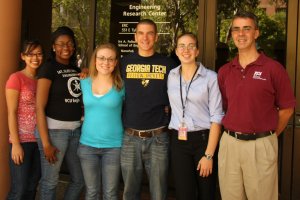Aug 11 2009
Five engineering students traveled to Arizona State University from across the country this summer for the opportunity to delve into advanced nanotechnology research with guidance from faculty of ASU's Ira A. Fulton Schools of Engineering.
 Electrical engineering professor Trevor Thorton (far right) and five students he helped introduce this summer to high-level nantechnology research.
Electrical engineering professor Trevor Thorton (far right) and five students he helped introduce this summer to high-level nantechnology research.
From June 1 to Aug. 7 they took part in the National Nanofabrication Infrastructure Network (NNIN) Research Experience for Undergraduates, a program supported by the National Science Foundation.
The nine-week session at ASU was overseen by Trevor Thornton, a professor in the School of Electrical, Computer, and Energy Engineering.
Christine Burdett (North Carolina State University), Ericka Cottman (Virginia Commonwealth University), Lillian Gong (Wellesley College), Claire McLellan (Wake Forest University) and Alex Sharenko (Georgia Institute of Technology) took on the challenge of Ph.D.-level nanotechnology research.
“It's very hands-on, with the students working in a laboratory setting, handling chemicals, using advanced tools to make nanostructures and then measuring them with state-of-the-art instruments,” Thornton said.
Faculty research advisors included: mechanical and aerospace engineering assistant professor Jonathan Posner; electrical engineering professor Yong-Hang Zhang and assistant professors Jennifer Blain Christen and Shalini Prasad; and Stuart Lindsay, a professor and research leader at the Biodesign Institute at ASU.
Students performed research in such high-tech specialties as nanotextured surfaces with nanomedical applications and nanoporous crystals for optoelectronic (light-controlled) devices.
“They get a chance to see what a research lab looks like two years before they have to decide if research is what they want to do,” Thornton said.
“Not only did I find it all incredibly interesting, but I gained so much valuable experience and knowledge in the process,” Christine Burdett said.
At the end of the program, students had the opportunity to present their research results in a four-day workshop at the NNIN convocation at the University of Michigan Lurie Nanofabrication Facility.
NNIN has offered its undergraduate research program for 13 years and made it one of the largest and most successful student programs in nanotechnology.
More than 600 applicants vied for the 80 openings at 13 universities in the highly competitive 2009 program.